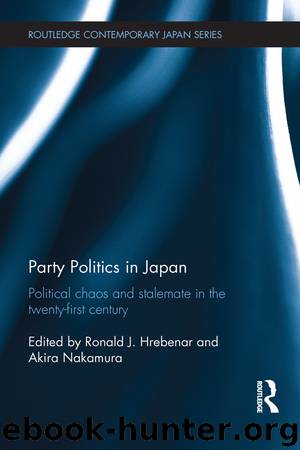Party Politics in Japan by Ronald J. Hrebenar & Akira Nakamura

Author:Ronald J. Hrebenar & Akira Nakamura
Language: eng
Format: epub
Publisher: Routledge
Turning election pledges into government programs 2009–2011: a flawed balance sheet
In its 2009 election manifesto, the DPJ had promised grand reforms in terms of both relevant government structures and policy substance. Already the first-mentioned promise proved easier made than turned into practice. The desired streamlining of executive decision-making structures in a government effectively run by elected political representatives rather than bureaucrats was not only difficult to come by but also rested on problematic assumptions from the outset. To start with, it was difficult to come by because the planned division of labor between DPJ politicians in government posts focusing on policy affairs and the rest focusing on electioneering and other party affairs proved unacceptable to many DPJ Diet members. During the party’s time in opposition, DPJ politicians had become used to shaping policy proposals through their membership in the party’s Policy Research Council (PRC), the main policy body of the DPJ. Especially politicians, who had not been given government posts, proved unwilling to cede their hitherto exercised role in shaping policy proposals to executive organs. The abolishment of the PRC in fall 2009 after the DPJ’s gaining power was thus met with great dissatisfaction from within the party, leading to an eventual reinstatement of the PRC after Kan had become premier in June 2010. His successor Noda Yoshihiko even boosted the powers of the PRC again by having policy-decisions of the government dependent on the approval of committee heads (Nihon Keizai Shimbun, December 23, 2009, p. 1 and September 4, 2011, p. 2). Moreover, as mentioned above, while Hatoyama was prime minister, Ozawa Ichiro as DPJ secretary general also made his influence in budget and policy-relevant processes felt, leading to a confluence of party and government structures. All in all, unified decision-making within the executive thus proved elusive after the DPJ had come to power.
Also, the DPJ’s idea to install, in the form of a National Strategy Bureau, a kind of “control tower,” charged with proposing and coordinating important budget and policy matters (cf. Takayasu 2009) did not make much headway. First, the DPJ had to realize that such a new structure, which was supposed to be able to give directions to national bureaucrats, required a legal foundation of its own. To circumvent this problem, the new unit was established inside the Cabinet Office as an office rather than a full-fledged bureau. From the beginning there were however important questions about its competences. An attempt to endow the national strategy unit with a proper legal basis finally floundered in spring 2011 as the government could not get the relevant bill also through the Upper House. By then the national strategy unit had already been degraded to a mere consultative organ, advising the prime minister on select issues, a function which it also had to share from fall 2011 onwards with a newly established National Policy Conference comprised of outside experts (Nihon Keizai Shimbun, August 8, 2010, p. 2 and October 29, 2011, p. 2).
What was also problematic about the DPJ’s
Download
This site does not store any files on its server. We only index and link to content provided by other sites. Please contact the content providers to delete copyright contents if any and email us, we'll remove relevant links or contents immediately.
The Vikings: Conquering England, France, and Ireland by Wernick Robert(77321)
Ali Pasha, Lion of Ioannina by Eugenia Russell & Eugenia Russell(39320)
The Vikings: Discoverers of a New World by Wernick Robert(36484)
Cecilia; Or, Memoirs of an Heiress — Volume 1 by Fanny Burney(31339)
Cecilia; Or, Memoirs of an Heiress — Volume 3 by Fanny Burney(30937)
Cecilia; Or, Memoirs of an Heiress — Volume 2 by Fanny Burney(30892)
The Conquerors (The Winning of America Series Book 3) by Eckert Allan W(27808)
Empire of the Sikhs by Patwant Singh(22174)
Hans Sturm: A Soldier's Odyssey on the Eastern Front by Gordon Williamson(16668)
The Secret History by Donna Tartt(16635)
Cat's cradle by Kurt Vonnegut(13873)
Sapiens: A Brief History of Humankind by Yuval Noah Harari(13062)
Pimp by Iceberg Slim(12936)
Leonardo da Vinci by Walter Isaacson(11907)
Talking to Strangers by Malcolm Gladwell(11889)
Norse Mythology by Gaiman Neil(11886)
Underground: A Human History of the Worlds Beneath Our Feet by Will Hunt(11261)
4 3 2 1: A Novel by Paul Auster(11053)
The Radium Girls by Kate Moore(10910)
